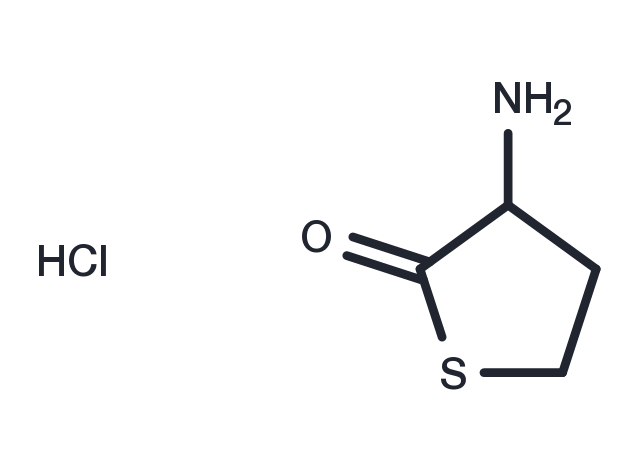Powder: -20°C for 3 years | In solvent: -80°C for 1 year


DL-Homocysteine thiolactone hydrochloride (DL-Homocysteinethiolactone hydrochloride) is a cysteine derivative that binds to and induces conformational changes in various plasma proteins, slowing coagulation and inducing oxidative stress. It decreases left ventricular systolic blood pressure and cardiac force and induces seizures in vivo.

| Pack Size | Availability | Price/USD | Quantity |
|---|---|---|---|
| 500 mg | In stock | $ 41.00 | |
| 1 g | In stock | $ 48.00 | |
| 1 mL * 10 mM (in DMSO) | In stock | $ 45.00 |


| Description | DL-Homocysteine thiolactone hydrochloride (DL-Homocysteinethiolactone hydrochloride) is a cysteine derivative that binds to and induces conformational changes in various plasma proteins, slowing coagulation and inducing oxidative stress. It decreases left ventricular systolic blood pressure and cardiac force and induces seizures in vivo. |
| In vitro | Acuted administration of DL-Homocysteinethiolactone hydrochloride (DL-Hcy TLHC) induces significant reduction of CF and partly of heart contractility, which confirms its cardiodepressive effect.?The simultaneous application of different inhibitors of important cardiovascular gasotransmitters with DL-Hcy TLHC shows that additional HO-1 inhibition induces more powerful effects than NOS or CSE inhibition.?The inhibition of CO production significantly increases DL-Hcy TLHC-induced effects on cardiodynamic parameters, while NOS and CSE inhibition only affects CF. Acuted administration of DL-Hcy TLHC and different gasotransmitter inhibitors does not show prooxidant potential[1]. |
| Cell Research | Only groups of hearts in which the CPP/CF relationship was studied twice in the absence of drugs were included in the study. After perfusion in the absence of any medication (control conditions), hearts were perfused with: 10?μM DL-Homocysteinethiolactone hydrochloride (DL-Hcy TLHC); 10?μM DL-Hcy TLHC + 30?μM L-NAME (N ω-Nitro-L-arginine methyl ester, an inhibitor of NOS); 10?μM DL-Hcy TLHC + 10?μM DL-PAG (DL-Propargylglycine, an inhibitor of cystathionine gamma lyase-CSE); 10?μM DL-Hcy TLHC + 10?μM ZnPPR IX (protoporphyrin IX zinc, an inhibitor of HO-1) and compared to the respective controls[1]. |
| Synonyms | DL-Homocysteinethiolactone hydrochloride |
| Molecular Weight | 153.63 |
| Formula | C4H8ClNOS |
| CAS No. | 6038-19-3 |
Powder: -20°C for 3 years | In solvent: -80°C for 1 year
DMSO: 25 mg/mL (162.74 mM)
You can also refer to dose conversion for different animals. More
bottom
Please see Inhibitor Handling Instructions for more frequently ask questions. Topics include: how to prepare stock solutions, how to store products, and cautions on cell-based assays & animal experiments, etc.
DL-Homocysteine thiolactone hydrochloride 6038-19-3 Metabolism Endogenous Metabolite inhibit DL-Homocysteinethiolactone hydrochloride DL-Homocysteine thiolactone Inhibitor DL-Homocysteine thiolactone Hydrochloride DL Homocysteine thiolactone hydrochloride DLHomocysteine thiolactone hydrochloride DL-Homocysteinethiolactone Hydrochloride inhibitor
